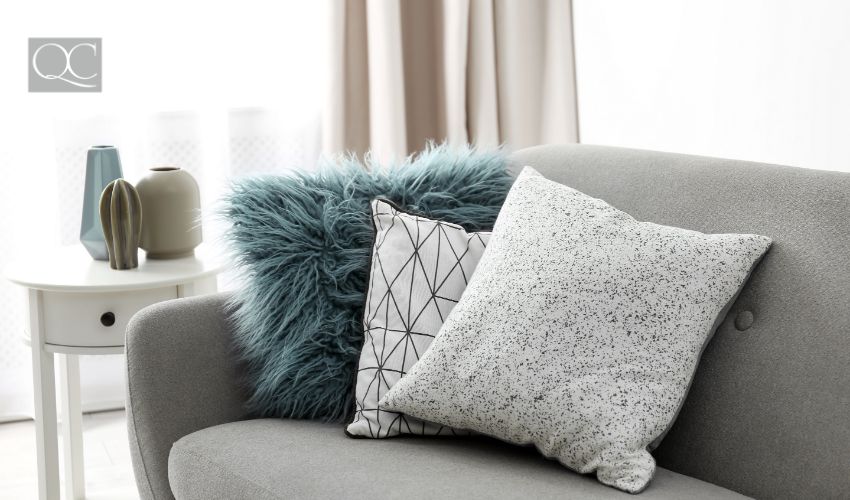Do you want to know how to become a home stager? If so, then you’ve come to the right place!
Chances are, you’ve got a lot of questions about this new career path. Well, you’re in luck – because we’ve answered ALL of them for you in the article below!
So, sit back, get cozy, and put your feet up. By the time you’ve finished reading, you’ll know everything you need to start your dream career ASAP!
Are Home Stagers in Demand?
The real estate market admittedly took a bit of a hit in 2020, thanks to the COVID-19 pandemic. But now that life is starting to return back to normal, the market is burning red-hot, with no signs of slowing back down!
Recent housing reports data indicates that the real estate market shows no signs of crashing again anytime soon. In fact, the current boom that the economy is experiencing is expected to hold strong for the foreseeable future. This makes sense when you consider all of the homeowners who were unable to list their houses during lockdowns.
Now that the coast is once again clear, everyone is making up for lost time and throwing up “For Sale” signs on their front lawns!
So, what does this mean for YOU?
In a nutshell, there couldn’t be a more perfect time to start a career as a home stager! In fact, if you were to begin your professional training now, you’ll be fully prepared to book your first client before 2021 is even over!
What Exactly Do Professional Home Stagers Do?
Okay, so you want to get started as a home stager… But do you know exactly what a professional stager actually does?
Don’t worry, we’ve got you covered on that, too!
Essentially, your job will be to make a living space as aesthetically-pleasing as possible before it’s listed on the real estate market. In order to achieve this, you’ll have certain responsibilities that’ll be a regular part of your job description.
Such responsibilities include (but are not limited to):
- Meeting with prospective clients and conducting consultations.
- Determining your clients’ budget (and then ensuring to stay within it).
- Assessing client needs and proposing logical suggestions in order to achieve their visions.
- Positioning and rearranging furniture (i.e. your clients’ furniture or furniture that’s been rented out for the staging process).
- Acquiring decor and/or accessories and then placing everything throughout the home.
- Partnering with real estate agents.
- Collaborating with a color consultant, painters, etc. to repaint the walls within the home.
- And SO much more!
Fun Fact: It’s statistically proven that professional home staging not only helps a listed home sell faster, but above asking price as well! Keep reading here to learn more!

How Much Do Home Stagers Make?
Salary Expectations
Now that you know how to work as a home stager, and what you’ll typically be doing, the next step is understanding how much you’ll be making. With this, it’s important to be realistic and keep a few key factors in mind.
Firstly, there’s no “one-size-fits-all” salary for a home stager. Your income will depend on:
- Where you live
- Whether you’re booking clients full-time vs. part-time
- Whether you’re running your own business or working for an established company
- The efforts you put into marketing, client acquisition and retention, social media, and your business website
- The types of services your business offers, etc.
That being said, we can give you some general figures to help you get a better idea of possible salary ranges. In Canada, for instance, Talent.com reports that the average annual income in 2021 (based on 19 home stager salaries) is $40,000 CAD, or approx. $20.51 CAD per hour.
In the United States, ZipRecruiter found that as of August 5, 2021, the average salary for home stagers is approx. $48,517 USD per year. As yet another example, Glassdoor reports that based on 446 salaries, home stagers in the United Kingdom make (on average) £30,635 annually – equal to approx. $42,312 USD.
The Added Value of a Home Staging Certification
One of the most effect ways of boosting your home stager salary is to get professionally trained. As a result of this training, you can then have a reputable certification on your resume!
Why is this critical? Because prospective clients will always prefer to work with a stager who’s taken the time to earn their stripes. Imagine that a customer has the option of hiring you (who has a certification) or someone who doesn’t have adequate training.
We guarantee that you’ll be the one who always books the project.
Furthermore, investing time, money, and effort into your education means you have the right to price your home staging services to properly reflect that. And if your design business offers any other types of services, you can afford to raise the rates of those, too!
Plus, having a credible home staging certification will do wonders in terms of helping you stand out from the local competition. (Or, at the very least, keeping you solidly on par with them.) The home staging industry is a competitive one.
So, setting yourself apart from the crowd will not only elevate your business – it’ll definitely help you better your bottom line!

What Qualifications Do You Need to Become a Home Stager?
Alright, so now that you have a solid understanding of how to be a home stager, what’s next? Well, you’re probably wondering, “Am I required to have any specific educational requirements, degrees, or certifications in order to legally work in this field?”
The short answer is “no” – except there’s a definite “but” to keep in mind…
Here’s the longer answer:
No, there are technically no actual requirements to working as a home stager. BUT that absolutely does NOT mean that proper certification training isn’t still 100% necessary. For reasons we touched on above, the easiest way to sum this up would be: not having a certification will drastically limit your career’s potential in the long run.
If you’ve been asking yourself, “How do you become a home stager?” then it’s likely because this is a career prospect you’re passionate about. Logically, if this is the case, don’t you want to be the best you can possibly be?
Did you know that QC Design School’s Home Staging and Staging for Designers Courses will both provide you with an International Staging and Redesign Professional (ISRP) double certification? Enroll today and earn yours in as little as 3-6 months!
Okay, we’ve gotten through all of the need-to-know prep work. By this point, you have a good idea of what this career will look like for you.
Now the real question is: how do you to actually become a home stager? What will it take for you to hone your skill-set, launch a successful career, and keep it going for the long haul?
Here are 7 steps to guide you in the right direction!
Step One: Learn More About The Home Staging Industry
If you want to know how to work as a home stager, you’ll first need a better idea of what the demand is like for stagers in your local area. So, do some research! Test out relevant SEO keywords/inquiries in search engines such as Google. This way, you can see the sort of questions homeowners are currently trying to have answered.
This research should help you grasp what the people in your area are looking for, in terms of home staging services. Moreover, it’ll also help you better understand whether or not the demand is high where you live. If it isn’t, you can figure out how you plan to adjust accordingly, in order to appeal to a larger range of clientele.
Speaking of conducting research, I also strongly recommend checking out your local competition!
Who are the other home stagers in your town or city? What are their businesses like? What’s their brand all about? How much do they charge for their services? What kinds of reviews have others left about them?
Sure, there’s no pressure for you to start your own business at this stage. But there’s never any harm in brainstorming ideas. And, of course, one of the best ways to brainstorm is to first understand your competitors!

Step Two: Take a Course on How to Become a Home Stager
By this stage, it’s time to get properly trained and certified as a home stager! The best place to start is by first deciding whether you want to do your schooling online or in-person. Once you’ve determined this, you can then conduct the necessary research and figure out which options are currently at your disposal.
(Insider tip: If you choose to do your training online, there will be a LOT more home staging courses available to you!)
Just keep in mind that regardless of whether the home stager program is online or in-person, it’ll need to meet the same criteria. After all, you want to get your money’s worth, don’t you?
In order to ensure the highest-quality education for your buck, I strongly recommend that you only consider home staging courses that:
- Are offered by legitimate, reputable schools with proper accreditation.
- Offer a full course curriculum breakdown on their business website.
- Are provided by an institution that has a comprehensive website, active social media presence, and communicative Student Support Team.
- Offer a good amount of hands-on experience.
- Are tutored by real experts in the design industry.
- Provide flexibility and convenience that best suit YOUR learning style.
- Fit your budget.
- Give you high-quality, extensive course materials (included within the course tuition).
- Provide an internationally-recognized certification once you graduate.
Guess what? QC Design School meets ALL of these criteria and more! Join our free Virtual Classroom on Facebook today, connect with current and former students, and see what they have to say about their QC experience!
Step Three: Test Your Home Staging Skills on Real Clients
As the old saying goes, “Practice makes perfect!”
So, get as much practice as possible! This will be especially beneficial as you first begin your career – before you book legitimate, paying clients.
The reason behind this is very simple: paying clients will expect the very best from you. In order to give them what they want and make the best possible impression for your business, you’ll need to know exactly what you’re doing. And ultimately, the best way to master your skills is to put them to ample use first.
Here are a few ways you can gain hands-on practice and in-field experience:
- Offer complimentary home staging services to your closest friends and family;
- Use your own home to test out different techniques and styles you learned during your training;
- Take part in a stylized photoshoot;
- Lend your expertise to a not-for-profit and/or charitable cause.
No, you likely won’t get paid for any of the above services. That said, the knowledge and skills you’ll acquire will more than make up for any money you would’ve made. In the world of professional home staging, hands-on experience is just as valuable as money – especially at the very start of your career!

Step Four: Build a Home Staging Portfolio
In the world of design, visual aids are everything. In many cases, your portfolio will be the very thing that creates a strong, favorable first impression for your business. Thus, if you want to become a home stager, you’re going to need a high-quality design portfolio.
When potential clients are thinking of working with a home stager, they’ll likely conduct their research on Google. From there, they’ll discover your website. If people are able to clearly find and view your design portfolio on your site, and all of your photos are of impressive quality, chances are they’ll reach out to you to book a consultation!
But if your portfolio is inadequate (or, worse, nonexistent), you could wind up turning away prospective customers before you’ve even had a chance to speak with them. Of course, no aspiring home stager wants that!
Want to learn more about developing the ultimate home stager portfolio? Check out QC Design School’s Accelerate Your Business Workshop and enroll today!
Step Five: Join Home Stager Groups and Networks
Networking
Networking will be your greatest asset as you become a home stager. It’s one of the single smartest ways to advance your career. This is because the design industry is a relatively close community.
As such, it won’t take long for you to meet and/or become acquainted with the other home stagers in your local area. Moreover, you’ll also get to know contractors, suppliers, and other types of designers.
Remember: just because other stagers are technically your “competition” does not mean they aren’t also allies, too. It’s important for you to establish positive connections with others in the industry – and this includes your competitors.
“But why is it important that I do this?” you might be wondering.
It’s quite simple, really. Whenever you network, you’re increasing your chances of getting referrals. Even other home stagers can sometimes send clients your way, if their own schedule is totally booked up. So long as they trust that you’d scratch their back if possible, so to say, then they’ll always be more than happy to scratch yours.
Ultimately, you’ll have a much more successful career if you network with other designers and stagers.
Home Stager Networks and Associations
You can also build your professional relationships by joining all sorts of online networks, too. Look around on popular social media platforms, such as Facebook, Instagram, Reddit, Twitter, Pinterest, and even TikTok.
Search for relevant, trending hashtags, follow other home stagers whose work you admire, and join groups. All of these are positive, proactive steps that will ultimately reward your career endeavors in one way or another in the long run.
Another proactive move we strongly recommend making is signing up for memberships with credible home staging associations. For instance, the Real Estate Staging Association (RESA) is a very popular option for those living in North America. Similarly, if you reside in Canada, you can also become a member of the Canadian Association of Renovators and Home Stagers (CARAHS).
Did you know that as soon as you become a student of QC Design School, you’re automatically eligible for a membership with both of these esteemed design associations? It’s true! Learn more about this here!

Step Six: Connect with Realtors and Property Management Companies in Your City
Earlier, I touched upon the fact that staging services are a major asset to other professionals in the real estate market. As such, many realtors and property management companies are eager to collaborate with a home stager, as they know stagers will help them help their client sell their home more successfully.
As you can see, this all circles back to the value of networking. Although there are tons of people in the design industry that we recommend forming connections with, those working in the real estate market are of particular importance. You’d be surprised how many realtors and property management companies can directly assist in you booking jobs, gaining clientele, and stocking your portfolio full of sensational content.
Brand-new to working with real estate agents? This blog article by QC Design School will teach you everything you need to know!
Step Seven: Keep Current with Design Industry and Staging Trends
Staying current is, ultimately, the very thing that will keep your home staging career successful over time. In order to start a career as a home stager, it’s imperative that you get properly trained and become a proper subject-matter expert.
But the truth is, taking just one or two courses at the beginning of your career simply won’t be enough.
Rather, your educational journey will be a lifelong effort. So, it’s important that you recognize and embrace this fact sooner rather than later. After all, the world of design is ever-changing. Thus, there will always be new trends to try, new lessons to learn, and new skills to master.
If you limit your training, you’ll be limiting your career’s potential. It’s really that simple. You – and your business – will subsequently become stagnant, and your clients will notice eventually.
To avoid this, continue to proactively build upon your training! Take more courses. Add more certifications to your resume. Browse social media during your downtime and read home staging publications.
All of this will help ensure that you stay on top of the newest, hottest trends. And, of course, when you keep your skill-set current and fresh, you’ll be able to make your mark on the home staging world for that much longer!
What Career Paths Can You Take as a Home Stager?
Here’s the beauty about becoming a home stager: once you’ve earned your internationally-recognized certification, the sky is really the limit for you! By that, I mean that there are all sorts of potential career paths you can choose to explore.
For starters, you’ll acquire the knowledge needed to launch your very own business, if that’s what your heart desires. Many of QC Design School’s graduates prefer this option because they’re attracted to the idea of being their own boss, setting their own hours, and having full control over their career endeavors. And since all of QC’s courses come with a full unit devoted entirely to business training, graduates are completely prepared to pursue this path as soon as they’ve finished their program!
Beyond this, you can also:
- Get hired by an existing home staging and/or design company;
- Offer your services on a freelance basis (i.e. to real estate agents, property management companies, interior decorators, etc.);
- Work primarily in real estate sales;
- Specialize in home staging for rentals;
- Provide home staging services for retirement residences;
- Stage furniture showrooms;
- Stage homes in preparation for private parties;
- And SO much more!




Taking the home staging course with QC has absolutely helped me in my design career! There are so many career paths that you can take after getting certified.
Thanks so much for reading and commenting, Daniella! We’re SO thrilled that QC Design School was able to help you become a home stager and provide all the necessary certification training you needed along the way. You’re a rock star and we appreciate you! <3
All the best,
The QC Team
So much amazing info on the certification and a huge, growing industry! A great article to find everything you need to know!
As a licensed real estate salesperson, I know firsthand how important staging is in the real estate industry! This article is a great resource for all!
Thanks so much for this amazing perspective and insight, Alexa! As a resl estate salesperson, how often would you say you encounter professional home staging services (and their benefits) when helping a client sell their home? 🙂
All the best,
The QC Team